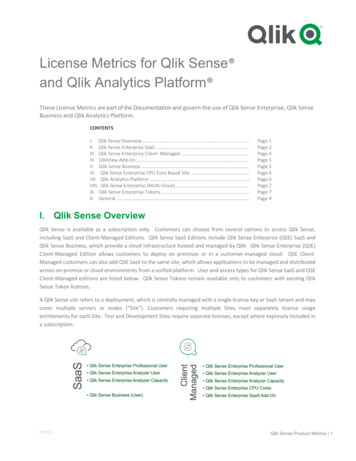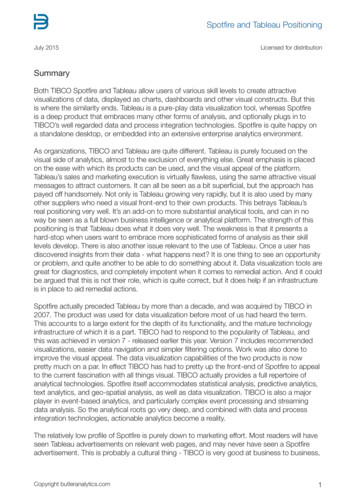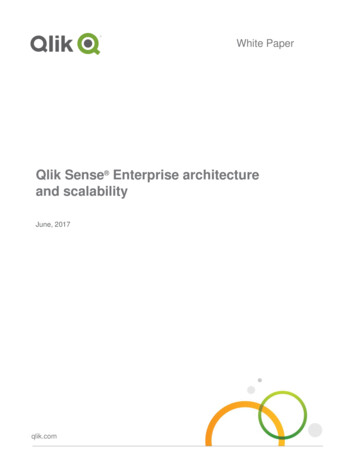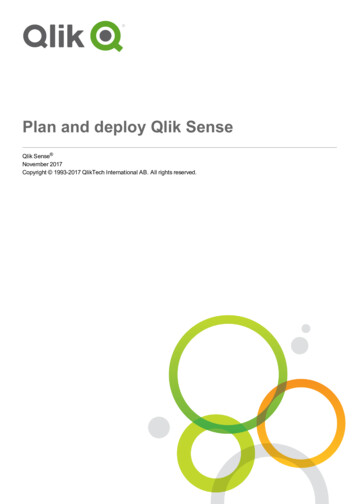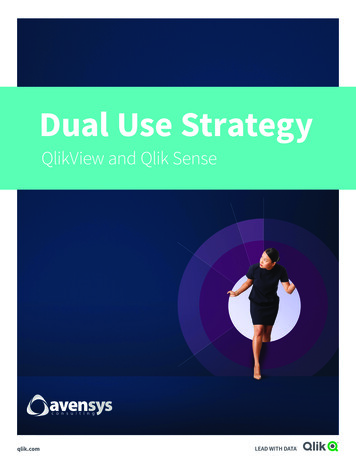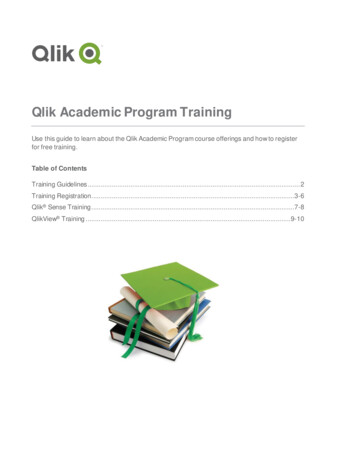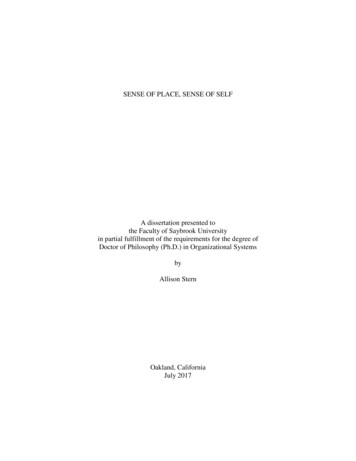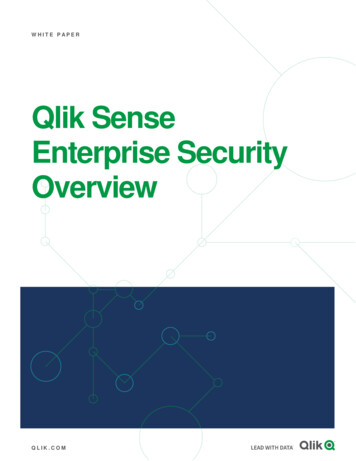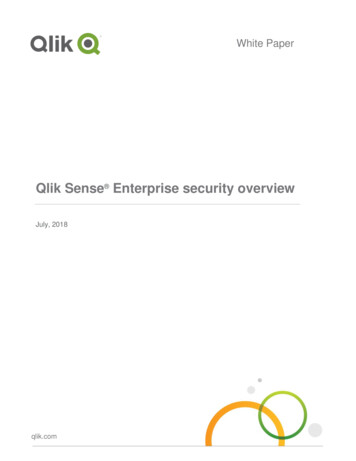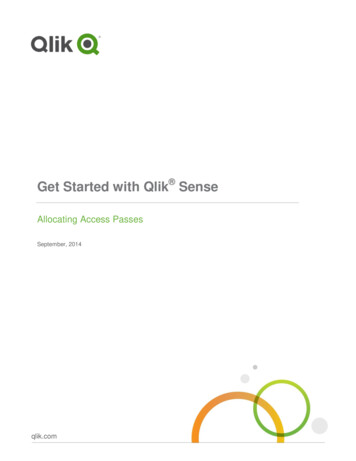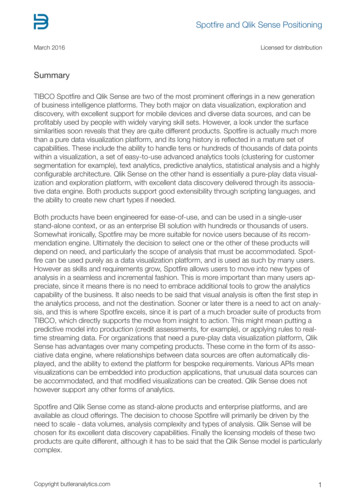
Transcription
Spotfire and Qlik Sense PositioningMarch 2016Licensed for distributionSummaryTIBCO Spotfire and Qlik Sense are two of the most prominent offerings in a new generationof business intelligence platforms. They both major on data visualization, exploration anddiscovery, with excellent support for mobile devices and diverse data sources, and can beprofitably used by people with widely varying skill sets. However, a look under the surfacesimilarities soon reveals that they are quite different products. Spotfire is actually much morethan a pure data visualization platform, and its long history is reflected in a mature set ofcapabilities. These include the ability to handle tens or hundreds of thousands of data pointswithin a visualization, a set of easy-to-use advanced analytics tools (clustering for customersegmentation for example), text analytics, predictive analytics, statistical analysis and a highlyconfigurable architecture. Qlik Sense on the other hand is essentially a pure-play data visualization and exploration platform, with excellent data discovery delivered through its associative data engine. Both products support good extensibility through scripting languages, andthe ability to create new chart types if needed.Both products have been engineered for ease-of-use, and can be used in a single-userstand-alone context, or as an enterprise BI solution with hundreds or thousands of users.Somewhat ironically, Spotfire may be more suitable for novice users because of its recommendation engine. Ultimately the decision to select one or the other of these products willdepend on need, and particularly the scope of analysis that must be accommodated. Spotfire can be used purely as a data visualization platform, and is used as such by many users.However as skills and requirements grow, Spotfire allows users to move into new types ofanalysis in a seamless and incremental fashion. This is more important than many users appreciate, since it means there is no need to embrace additional tools to grow the analyticscapability of the business. It also needs to be said that visual analysis is often the first step inthe analytics process, and not the destination. Sooner or later there is a need to act on analysis, and this is where Spotfire excels, since it is part of a much broader suite of products fromTIBCO, which directly supports the move from insight to action. This might mean putting apredictive model into production (credit assessments, for example), or applying rules to realtime streaming data. For organizations that need a pure-play data visualization platform, QlikSense has advantages over many competing products. These come in the form of its associative data engine, where relationships between data sources are often automatically displayed, and the ability to extend the platform for bespoke requirements. Various APIs meanvisualizations can be embedded into production applications, that unusual data sources canbe accommodated, and that modified visualizations can be created. Qlik Sense does nothowever support any other forms of analytics.Spotfire and Qlik Sense come as stand-alone products and enterprise platforms, and areavailable as cloud offerings. The decision to choose Spotfire will primarily be driven by theneed to scale - data volumes, analysis complexity and types of analysis. Qlik Sense will bechosen for its excellent data discovery capabilities. Finally the licensing models of these twoproducts are quite different, although it has to be said that the Qlik Sense model is particularlycomplex.Copyright butleranalytics.com1
Spotfire and Qlik Sense PositioningMarch 2016SpotfireAs one of the most complete visual analytics platforms available, Spotfire anticipates many ofthe emerging trends in business intelligence and data visualization. It successfully combinesease-of-use with advanced capabilities, makes pervasive visual analytics available to users ofevery skill level, provides powerful visual data preparation capabilities for complex data, andhas advanced analytics built in. More recently it has embraced additional big data resources,including SparkSQL, SparkR, SAP Hana and enhanced support for OLAP. For enterprisescale deployment, Spotfire now supports cloud type scaling and management of the run-timearchitecture. This means compute resources can be programmed to automatically adapt todiffering workloads.There are many productivity enhancers embedded into Spotfire: Visualizations are recommended based on the data being analyzed – a capability especially valuable for novice usersto kick-start their analytics experience with minimal training; Grouping - data can be groupedso that several values are treated as a single value (different spellings of a city for example).A large number of functions ease the job of data preparation, and the user interface is enhanced through support for multiple monitors, with all visualizations interlinked. Collaborationis a strong point in Spotfire where users can create a dialogue about specific issues or insights found in their data, save views and discoveries on each message within the conversation. Similarly, annotations allow users to add commentary to their analysis and be included ina dialogue.Spotfire comes in three flavors: Spotfire Desktop is a stand-alone Windows program withconnectivity to a large number of data sources, Spotfire Platform is a server based implementation for departments and businesses, and Spotfire Cloud provides the same businessauthor and consumer clients as Spotfire Platform (with a couple of analytical tools absent),but hosted in the cloud. It needs to be emphasized that Spotfire’s architecture is capable ofhandling visualizations with hundreds of thousands of data points - without breaking a sweat.Here is a brief summary of the functionality provided by each:Spotfire Desktop runs on a Windows desktop computer and can access both local andremote data sources. These sources are too numerous to list here, but whatever data sourcea user might need to access, it’s likely Spotfire can accommodate it. The user interface andease-of-use factor was significantly improved with version 7, providing recommended visualizations, easier data management and more attractive visualizations. It is difficult to see howthe user experience could be more accommodating, even for complex visualization tasks.Some advanced chart types are supported including heat maps, 3-D scatter plot, mapcharts,treemaps, box-plot etc. The analytical tools really distinguish Spotfire Desktop, and typicallydo not require any coding at all. Predictive analytics, location analytics, hierarchical clustering,forecasting and a large number of data functions come as standard. Dashboards and chartscan be exported to PDF, Powerpoint, Html, or data file.Spotfire Platform is server based and provides an enterprise data exploration and visualization environment with several powerful analytical tools. A web based interface supportsCopyright butleranalytics.com2
Spotfire and Qlik Sense PositioningMarch 2016business authoring of visualizations, and a consumer client allows viewing through the webbrowser. As with the desktop version, a large number of data sources can be accessed,and network graphs (an add-on for network analysis) are added to the chart types. Platformcomes with the same analytical tools as Desktop with the addition of the R Runtime Server- an optimized environment for running R analytics tasks. Several services are also availableincluding: Advanced Data Services - for integrating data from diverse sources.Automation Services - for scheduling analysis and reports, with email distribution.Location Analytics - for analysis that involves the location of objects, people and events.Statistical Services - with support for R, S , SAS and MATLAB native functions.Various mechanisms exist to share reports and dashboards, and a Guided Analytics facility isavailable in all three versions to tell a visual data story. A conversation panel allows users totrack comments, and a web panel supports integration with any external web tools (TIBCOoffers tibbr - one such tool).Spotfire Cloud is targeted at workgroups and comes with the business authoring and consumer web based clients. Users can build their visualizations completely within the webbased client, and consumers can view them in the browser as well. A secure area is providedto share visualizations and collaborate, or if desired they can be broadcast publicly to asmany consumers as necessary. An Enterprise version of Spotfire Cloud is available as a dedicated instance.Spotfire ArchitectureThe speed of Spotfire is greatly enhanced by its clever memory and data management. Formore modest data sets the in-memory processing ensures very high performance. Largerdata sets can be processed in-database, and a hybrid approach called On-Demand optimizes the data held in local memory and that held in the database. This is unique to Spotfire.For more advanced analytics there is the TIBCO Enterprise Runtime for R (TERR), providing ahigh performance production environment to run R scripts, and TIBCO Spotfire Statistics Services (TSSS). This integrates R, S , SAS, MATLAB and in-database analytics into the Spotfireecosystem. The accommodation of R is worthy of note since the execution of R scripts hasbeen parallelized and the TERR engine is compatible with the RStudio IDE (much loved bymany R analysts).The Spotfire Server manages a library of analysis files, takes responsibility for authenticationand authorization, persists links to external data sources and runs on Linux, Solaris and Windows. A core component in this is the Web Player. This cleverly normalizes data access byrouting users to Web Player instances already accessing relevant data sources. New instances can be created as needed, giving virtually unlimited horizontal scalability.Copyright butleranalytics.com3
Spotfire and Qlik Sense PositioningMarch 2016Spotfire SummaryThe central feature of Spotfire that distinguishes it from nearly all the competition is the abilityto start with easy to use desktop data visualization tools, and as needs and skills develop, tomigrate to a full enterprise analytics environment. It satisfies the needs of novice users, business managers, data analysts, and data scientists in one homogeneous environment. Noviceusers will find a supportive, guided experience, while advanced users can develop and deploy very advanced analytics on big data using the Spark architecture. In this sense Spotfireis unique, and in the context of TIBCO’s broader product architecture businesses can moveall the way from insight to action in one seamless environment. Spotfire is essentially analyticswithout boundaries. The most important differentiators of Spotfire are:1 A single environment for novice and expert users alike.2 Ahead of the visual analytics curve with advanced analytics and excellent data preparationfor complex data.3 Highly scalable and programmable architecture for demanding requirements.4 High visual analytics productivity through recommended visualizations and guided interface.5 Part of a broader analytics capability with a direct route from insight to action.Copyright butleranalytics.com4
Spotfire and Qlik Sense PositioningMarch 2016Qlik SenseQlik Sense is a drag-and-drop data visualization and discovery platform capable of addressing most business intelligence needs apart from heavy duty production reporting. It deliversan easy-to-use interface suited to all levels of skill, and has a substantial amount of in-builtintelligence to help users along. Charts, tables and dashboards are its main currency, ofalmost any level of complexity – or simplicity. Users can share their visualizations via variousmechanisms and the platform was built ground up for mobile access – no matter the device(visualizations are rendered in HTML5).Perhaps the most significant Qlik Sense differentiator is its associative data engine. This understands the links between various data sources and can suggest previously unsuspectedrelationships. It allows users to freely explore visualizations and objects, refining contextthrough selections and keyword searches. Many suppliers use the term ‘data discovery’, butthis facility adds new meaning to the term.It comes in two versions – Qlik Sense Desktop, which is free to download and is not throttledin any way. It runs on a Windows desktop and is capable of accessing many data sources.Qlik Sense Enterprise runs on a server(s) and provides users with a browser based interface.Both editions have similar functionality, but the server platform offers collaboration, mobile,and governance capabilities, and can scale to serve global distributed enterprises through itsexcellent scalability and distributed architecture. Qlik has always offered excellent governanceof its environment, and IT has the tools to ensure data is secure, unambiguous and that theright people get to the right data.Very importantly Qlik Sense is extensible. Not a very sexy attribute perhaps, but one thatdistinguishes the adults from the children in the world of enterprise business intelligence. Infact Qlik Sense is one large extension, built on itself! A large number of APIs are available forembedding visualizations into production applications, creating custom data connectors andbuilding new visualization types. Developers will have absolutely no problem extending QlikSense, if that is what is needed. Finally Qlik Sense is fast – its in-memory columnar associative engine guarantees that.Qlik Sense is the perfect fit for organizations who need easy-to-use data visualization anddiscovery tools, but may also want the head room to accommodate more advanced levels ofsophistication. It is an enterprise solution, with its governance and developer support capabilities. Businesses looking for an enterprise production reporting platform (invoices etc) shouldlook elsewhere, as should users who needs a few simple charts, since they would find QlikSense overkill. Qlik Sense does not come with any advanced statistical or predictive analyticscapability, but that is not its domain.Qlik Sense DesktopQlik Sense Desktop is the entry level product, and it can be freely downloaded – the fullversion. Out of the box it easily connects to desktop data sources such as Excel and CSVCopyright butleranalytics.com5
Spotfire and Qlik Sense PositioningMarch 2016files. From version 2.0 onward, the job of connecting to other data sources has been madevery much easier. Smart Data Load allows many sources to be specified, and profiles thedata sources to suggest the best links between them. ODBC connectors are available for anumber of sources, and Qlik DataMarket provides third-party data as a service, directly fromwithin Qlik Sense. Once data can be accessed it is loaded into the in-memory associativedata engine, where it is compressed for speed. Performance is very good provided the datafits into memory, and since it is compressed, an awful lot of data can be accommodated. Virtually every kind of chart is supported. The central construct in Qlik Sense is the sheet – thiscan contain charts, tables, images and filters. A sheet can consist of many visualizations. Thedesktop version supports the distribution of visualizations via file. To add to the appeal of thedesktop version, and to whet the appetite, Qlik Sense Cloud allows users to upload visualizations and share them with up to 5 users – again for free. The data exploration capability ishelped considerably by the associative engine. This color codes data sources to indicate therelationship they have with data sources already being used. Green indicates a data sourceis already being used, white means there is an association (which you may not already knowabout), and gray indicates there is no relationship.Qlik Sense EnterpriseThe server based Qlik Sense Enterprise provides similar capability to the desktop version,but with added collaboration features, mobile access, scalability, data management, governance and platform management, and a distributed architecture. Users get full functionalitythrough a browser based interface – even on mobile devices. Visualizations can be created,viewed, shared and managed through this single interface. Clever resizing of charts andobjects means visualizations fit on almost any device display – a natural outcome of the factQlik Sense was built ground up for mobile and touch devices. The Qlik Sense architecture issophisticated – perhaps one of the most sophisticated in this genre of technology. There arearound a dozen components in this architecture, which can mostly be deployed on differentservers for scalability. Here is a quick run-down: The Hub delivers the Qlik Sense environment through a browser interface Qlik Sense Proxy manages sessions, handles load balancing, handles identity (e.g. ActiveDirectory), and is essentially the entry point for users coming in through the Hub, or viathe Management Console. Qlik Sense Engine is in many ways the heart of the system, with its in-memory columnardatabase. It is RAM based and delivers visualizations, search results and run-timecalculation to users. Qlik Sense Scheduler coordinates the loading of data, and looks after time based reloadsand data dependencies. Qlik Sense Applications comprise data, a data model and the presentation layer. These areloaded by Qlik Sense Engine. The Management Console is for admin to manage data connections, security, auditing andother matters. A deployment console gives access to the deployment environment (Qlik Sense can run invirtual machine environments – VMware vSphere, and Amazon AWS).Copyright butleranalytics.com6
Spotfire and Qlik Sense PositioningMarch 2016These are the main components and they provide great flexibility. It means Qlik Sense canscale in almost any manner needed, and multinational businesses can split components overdifferent regions, if needed.Development and AdministrationDevelopers get the same drag-and-drop environment as users. Several APIs make life easierand the product extendible. The main ones are:1234Qlik Sense API to build new visualization types.Qlik Sense Mashup API/.NET SDK to embed visualizations and other functionality.Qlik Sense QVX SDK to create custom data connectorsQlik Sense Engine API for direct communication with the associative engine.Management of the environment is aided by a shared object library for pre-built data, expressions and visualizations. Access to resources can be tuned to user skill level, and access todata sources controlled by security rules. Streams allow fine control over who gets access toa visualization, and in which modes (read, update, modify, delete). The management and governance environment provided by Qlik Sense provides everything a large (and not so large)organization might need.OEMs can use the Qlik Analytics Platform, a new offering allowing developers to embed Qlikvisualizations into applications through web mashups, or by embedding into custom applications.Qlik Sense SummaryQlik Sense can be summarized by five key concepts:12345It is an easy to use data visualization and exploration platform.It supports a level of data discovery that is probably unequalled by any other platform.Extensibility is built into the product architecture.It inherits the mature governed environment of QlikView.It is built ground up for full use on mobile devices.These are the primary differentiators, but scalability, story-telling, and other features expectedof a platform of this nature are in general above average in terms of capability.Copyright butleranalytics.com7
Spotfire and Qlik Sense PositioningMarch 2016ConclusionIt should be clear that Spotfire and Qlik Sense are wholly different offerings, even thoughthey are often put under the single umbrella of visual analytics. Spotfire has anticipated manyof the emerging trends in visual analytics and business intelligence through its seaml
Spotfire comes in three flavors: Spotfire Desktop is a stand-alone Windows program with connectivity to a large number of data sources, Spotfire Platform is a server based imple-mentation for departments and businesses, and Spotfire Cloud provides the same business
